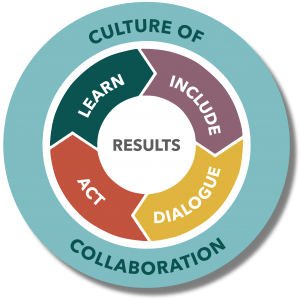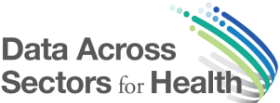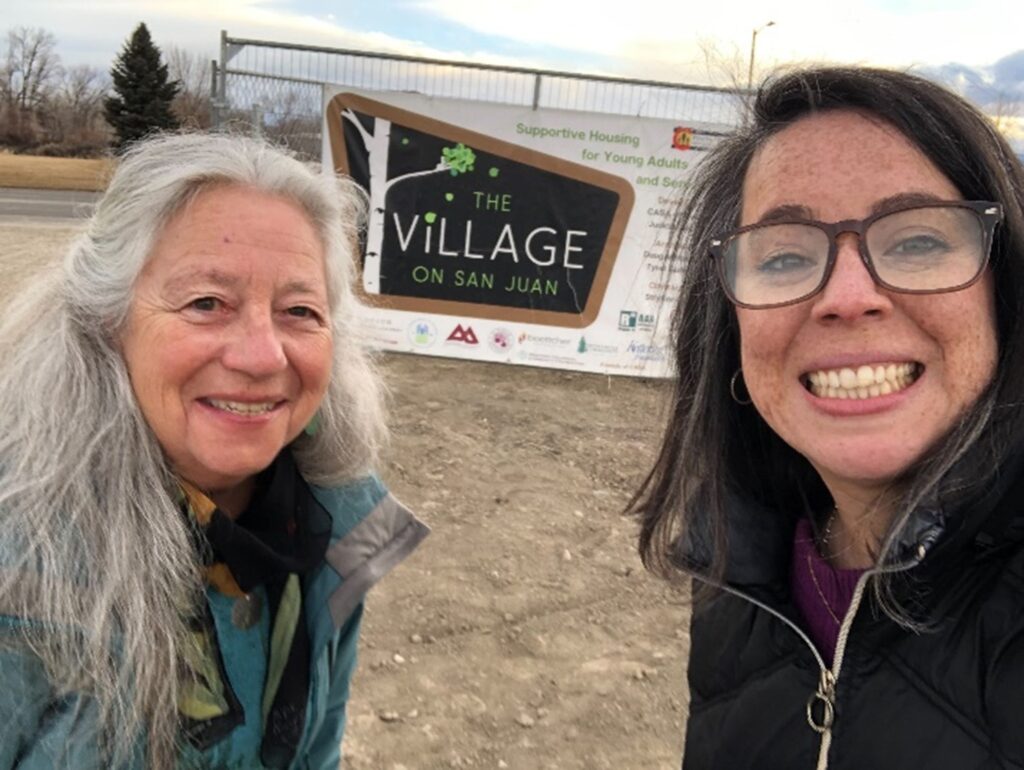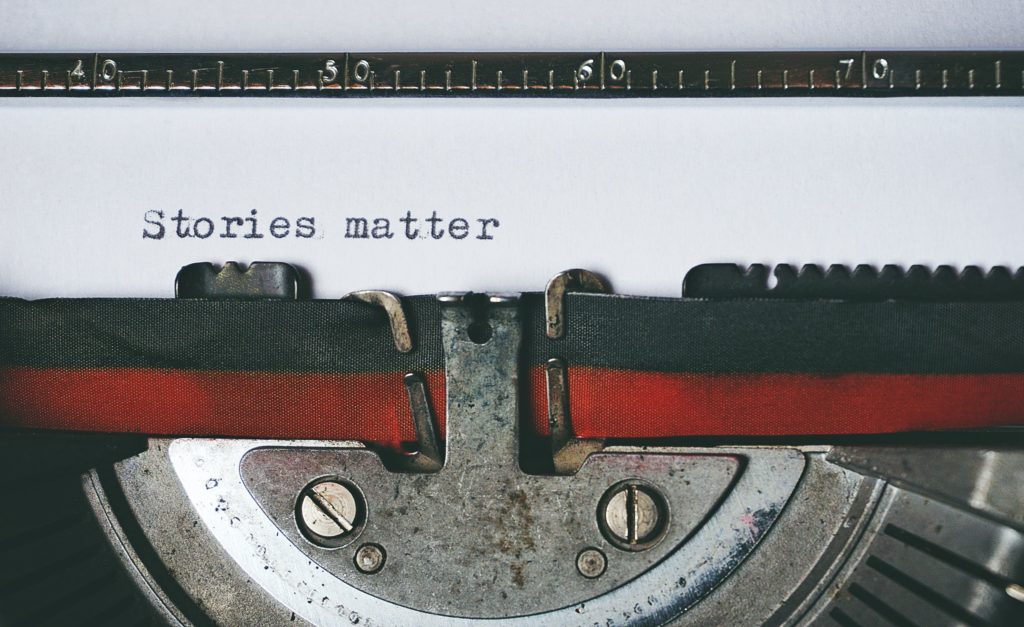Community Learning Model
Our vision is thriving communities in which all participate, prosper, and reach their full potential. It may look familiar. It’s a common definition of what equity looks like in practice. We recognize that not everyone has the same opportunities and obstacles on their way to their full potential. To make this vision a reality, we need to address the inequities, or unique barriers to success, that stand in the way.
To achieve our vision, The Civic Canopy designs and facilitates public processes using a research-based Community Learning Model (CLM). The CLM puts results at the center to create meaningful, measurable change on social issues. Those results are achieved through a continuous learning process of including relevant and diverse stakeholders, engaging in thoughtful dialogue, developing action plans, and learning from efforts to achieve results–all within a culture of trust and collaboration.

Results
Clear articulation of the results sought is at the center of the model. The desired results and the re-assessment of them drive the community learning process.
Include
Ensure the various people, perspectives and systems involved in the work are engaged in the process.
Dialogue
Create a high-quality conversation that clarifies values, surfaces tensions, and taps into creativity, leading to concrete plans that achieve results.
Act
Make sure the planning leads to action, both within planning processes and at each stage of implementation.
Learn
Set benchmarks and use indicators to assess the impact and quality of actions; learn from experiences and translate that information into more effective actions.
Culture of Collaboration
Strengthen the capacities that support collaborative work such as facilitative leadership, communication, and information sharing.
CLM Equity Standards
For communities to participate, prosper, and reach their full potential, each stage of the CLM needs to reflect that same commitment to equity. Without it, decisions tend to be short-sighted, programs poorly implemented, or buy-in lackluster because those farthest from opportunity weren’t included. Achieving equity isn’t just about where we’re going, it’s also about how we get there.
The following outlines the Equity Standard of Practice for each area of the CLM. We recognize that while these are standards, we, as well as our partners, have strengths and opportunities for growth. Progress toward these standards may fall along a continuum toward equity. We join you as a learning partner along that journey. If you come across a term or concept that is new to you, check out the Racial Equity Tools Glossary. Included with each are examples of how you will see the standard in practice when working with The Civic Canopy.
Take Our Collaboration Quiz
Interested to see how your collaborative group stacks up against others? Take our collaboration quiz to see which areas of the Community Learning Model you currently excel in and which you should focus on improving.
Results
Clear articulation of the results sought is at the center of the model. The desired results and the re-assessment of them drive the community learning process.
Equity Standard
Equity is defined in tangible terms through indicators that measure what it means for a community to thrive and for all people to have the opportunity to reach their full potential.
Standard in Action
While working with the Canopy, you can expect us to:
- Draw upon research on specific measures of inclusive prosperity needed to ensure that every person, especially those who have been excluded from opportunities, fulfills their full potential.
- Make sure that results are crafted by people personally affected by the issue and focus on changes for those with the largest impacts through targeted universalism.
- Look toward future achievements while learning from the past, building on the Seventh Principle. Question why something is the way it is today—what are the historical and structural conditions that got us here? Use root cause analysis tools to address the cause, not just the symptoms.
- Use not one, but many ways of collecting data to meet the diverse needs of those who provide information or data. This can include surveys but can also include methods like photovoice, archival story collection, or ripple effect mapping.
- Divide the data to discover differences based on populations people are a part of (e.g. race, gender, age). Using this disaggregated data, focus on disparities individual groups face in achieving a shared goal.

Case Study: Data Across All Sectors for Health Mentorship
In today’s world, collecting data isn’t the problem. It’s making sense out of it. The All In network works to helps communities across the U.S. use data to improve community
Include
Ensure the various people, perspectives and systems involved in the work are engaged in the process.
Equity Standard
All those affected by an issue have a meaningful opportunity to influence action on the issue.
Standard in Action
While working with the Canopy, you can expect us to:
- Assess and foster the readiness of a collaborative to engage diverse groups through their existing relationships, understanding of identity, and practice of cultural humility.
- Engage those affected by an issue through removing barriers and increasing the benefits of participation.
- Remove any barriers that prevent people from getting to the conversation (ex. transportation, technology, childcare) and remove barriers that prevent people from participating once they join the conversation (ex. language access, knowledge, physical/psychological safety).
- Increase the rewards for engaging with material things, like gift cards and food, or symbolic rewards, like recognition and reputation.
- Create an inclusive environment focusing on two of humans’ strongest needs, 1) the need to be unique in some way, and 2) the need to belong. Take the time to build relationships within a group to create trust and a shared identity.
Case Study: AmeriCorp Planning for Youth Peer Support Specialists
Initiated by the Colorado Department of Human Services, Office of Behavioral Health, COACT connects leaders in the field of youth services, human services, and education. COACT knew they were interested
Dialogue
Create a high-quality conversation that clarifies values, surfaces tensions, and taps into creativity; leading to concrete plans that achieve results. Establish conditions of genuine respect for the views and needs of the other.
Equity Standard
Conversations honor the legitimacy and value of diverse forms of communication and ensure all voices in a process are heard on equal terms.
Standard in Action
While working with the Canopy, you can expect us to:
- Be multipartial and anti-oppressive facilitators. Rather than pretending to be impartial, we get clear on any biases or opinions that could impact a conversation beforehand and revisit them throughout. Acknowledging them allows us to address them. Then, as we listen and guide, we work to ensure all voices are heard and understood. This can include:
- Providing the tools or the set up to ensure people are listening as much as they are talking.
- Asking people to express themselves in different ways, such as talking, drawing, writing, or moving.
- Notice when people get tense and address it. Oftentimes this means drawing attention to power dynamics and types of oppression that prevent us from speaking freely.
- Creating a physical environment that allows people to engage, whether that’s providing breaks, offering food, working alongside interpreters, or choosing a location that allows people to show up as they are.

Bringing Partners Together: Launching Collective Action
The Idea It started as an idea to meet a need. Carlton Mason, Director of CASA of the 7th Judicial District, saw a real need for youth in his program.
Act
Make sure the planning leads to action, both within planning processes and at each stage of implementation.
Equity Standard
Responsibility for action is distributed across the group, the diverse assets of group members are fully engaged, and any symbolic and/or material rewards for actions taken are disbursed fairly.
Standard in Action
While working with the Canopy, you can expect us to:
- Identify not just new programs, but actions that change the policies, relationships, power dynamics, and ways of thinking that hold problems in place. Lasting change requires people change both how they act and what they do.
- Recognize that everyone has gifts to contribute using an Asset Based Community Development (ABCD) approach.
- Balance the use of structured tools (like SMARTIE Goals or Results Based Accountability) while knowing that successful strategy is emergent. Simply coming together and better understanding one another creates ripple effects of action.
- Spread the work around. Action may not look the same for everyone, but everyone has a part to play. Make sure everyone sees the rewards of that action, whether it’s getting celebrated in the press (symbolic benefit) or receiving a gift card (material benefit).

Case Study: Communicating for Social Change Toolkit
Usually, the saying goes, “all talk and no action.” This project flips that idea on its head. Instead, the Canopy wanted to explore the impact of the stories we tell
Learn
Set goals and use measures to test the impact and quality of actions; learn from experiences and translate that information into more effective actions. Actors remain accountable to a shared vision and “return learning to the system” as a mutual contribution.
Equity Standard
Each collaborator contributes to a collective process of continuously capturing, sharing, and applying lessons that reflect diverse methods of gaining and creating knowledge that remain accountable to the agreed upon results.
Standard in Action
While working with the Canopy, you can expect us to:
- Push against the perfectionism, individualism, and emphasis on efficiency that prevent groups from trying new ideas, learning from failure, or trusting the knowledge of people with lived experience.
- See learning as something that happens again and again. A growth mindset allows groups to gather information and adapt, while understanding that no one ever “arrives” at the one true answer.
- Use tools like emergent learning and scenario planning to gather the wisdom of diverse thinkers for a 360° view. From there, groups can adjust their approach in real-time based on what they learned.
- Share the knowledge. People who contribute to learning, whether through a survey or storytelling, deserve to know what came of it.
The AEOC: Balancing Responsiveness and Long-Term Goals
Northwest Aurora is home to a vibrant community made up of one of the most diverse populations in Colorado. It is also a historically underserved region facing increasingly constant challenges
Culture of Collaboration
Strengthen the capacities that support collaborative work such as facilitative leadership, communication, information sharing and shared accountability. These elements strengthen the ability to move through the stages of the Community Learning Model.
Equity Standard
Enable all collaborators to contribute their strengths by attending to power, access, and the larger systems within which the collaborative is embedded.
Standard in Action
While working with the Canopy, you can expect us to:
- Create brave spaces for people to develop the trust and safety needed to engage in difficult conversations, sitting in the discomfort that leads to true understanding.
- Develop ways of working together (like constellation governance) that spread roles and responsibilities throughout a group. Ensure that collaborators have power with one another, rather than power over one another.
- Look at the ways that the collaborative connects to institutional, organizational, or cultural norms. Question the way these norms have helped or hurt efforts in the past.
- Recognize when collaboration isn’t the right fit or when stretch collaboration is needed.
Community Capacity to Shift Paradigms
A new teammate at the Canopy recently asked me about the term we use “transferring capacity”—we even have a neat graphic to explain how we believe that our role is

